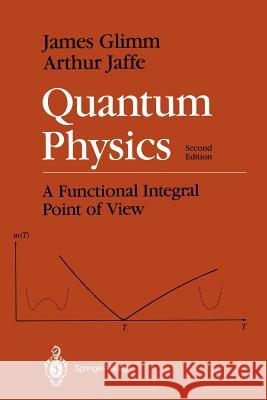Quantum Physics: A Functional Integral Point of View » książka



Quantum Physics: A Functional Integral Point of View
ISBN-13: 9780387964775 / Angielski / Miękka / 1987 / 535 str.
Quantum Physics: A Functional Integral Point of View
ISBN-13: 9780387964775 / Angielski / Miękka / 1987 / 535 str.
(netto: 613,40 VAT: 5%)
Najniższa cena z 30 dni: 616,85
ok. 22 dni roboczych.
Darmowa dostawa!
Describes fifteen years' work which has led to the construc- tion of solutions to non-linear relativistic local field e- quations in 2 and 3 space-time dimensions. Gives proof of the existence theorem in 2 dimensions and describes many properties of the solutions.
Wydanie ilustrowane
I An Introduction to Modern Physics.- 1 Quantum Theory.- 1.1 Overview.- 1.2 Classical Mechanics.- 1.3 Quantum Mechanics.- 1.4 Interpretation.- 1.5 The Simple Harmonic Oscillator.- 1.6 Coulomb Potentials.- 1.7 The Hydrogen Atom.- 1.8 The Need for Quantum Fields.- 2 Classical Statistical Mechanics.- 2.1 Introduction.- 2.2 The Classical Ensembles.- 2.3 The Ising Model and Lattice Fields.- 2.4 Series Expansion Methods.- 3 The Feynman-Kac Formula.- 3.1 Wiener Measure.- 3.2 The Feynman-Kac Formula.- 3.3 Uniqueness of the Ground State.- 3.4 The Renormalized Feynman-Kac Formula.- 4 Correlation Inequalities and the Lee-Yang Theorem.- 4.1 Griffiths Inequalities.- 4.2 The Infinite Volume Limit.- 4.3 ?4 Inequalities.- 4.4 The FKG Inequality.- 4.5 The Lee-Yang Theorem.- 4.6 Analyticity of the Free Energy.- 4.7 Two Component Spins.- 5 Phase Transitions and Critical Points.- 5.1 Pure and Mixed Phases.- 5.2 The Mean Field Picture.- 5.3 Symmetry, Breaking.- 5.4 The Droplet Model and Peierls’ Argument.- 5.5 Some Examples.- 6 Field Theory.- 6.1 Axioms.- (i) Euclidean Axioms.- (ii) Minkowski Space Axioms.- 6.2 The Free Field.- 6.3 Fock Space and Wick Ordering.- 6.4 Canonical Quantization.- 6.5 Fermions.- 6.6 Interacting Fields.- Appendix to Part I. Hilbert Space Operators and Functional Integrals.- A.1 Bounded and Unbounded Operators on Hilbert Space.- A.2 Positive Operators and Bilinear Forms.- A.3 Trace Class Operators and Nuclear Spaces.- A.4 Gaussian Measures.- A.5 The Lie Product Theorem.- A.6 The Bochner-Minlos Theorem.- A.7 Stochastic Integrals.- A.8 Stochastic Differential Equations.- II Function Space Integrals.- 7 Covariance Operator = Green’s Function = Resolvent Kernel = Euclidean Propagator = Fundamental Solution.- 7.1 Introduction.- 7.2 The Free Covariance.- 7.3 Periodic Boundary Conditions.- 7.4 Neumann Boundary Conditions.- 7.5 Dirichlet Boundary Conditions.- 7.6 Change of Boundary Conditions.- 7.7 Covariance Operator Inequalities.- 7.8 More General Dirichlet Data.- 7.9 Regularity of CB.- 7.10 Reflection Positivity.- 8 Quantization = Integration over Function Space.- 8.1 Introduction.- 8.2 Feynman Graphs.- 8.3 Wick Products.- 8.4 Formal Perturbation Theory.- 8.5 Estimates on Gaussian Integrals.- 8.6 Non-Gaussian Integrals, d = 2.- 8.7 Finite Dimensional Approximations.- 9 Calculus and Renormalization on Function Space.- 9.1 A Compilation of Useful Formulas.- (i) Wick Product Identities.- (ii) Gaussian Integrals.- (iii) Integration by Parts.- (iv) Limits of Measures.- 9.2 Infinitesimal Change of Covariance.- 9.3 Quadratic Perturbations.- 9.4 Perturbative Renormalization.- 9.5 Lattice Laplace and Covariance Operators.- 9.6 Lattice Approximation of P(?)2 Measures.- 10 Estimates Independent of Dimension.- 10.1 Introduction.- 10.2 Correlation Inequalities for P(?)2 Fields.- 10.3 Dirichlet or Neumann Monotonicity and Decoupling.- 10.4 Reflection Positivity.- 10.5 Multiple Reflections.- 10.6 Nonsymmetric Reflections.- 11 Fields Without Cutoffs.- 11.1 Introduction.- 11.2 Monotone Convergence.- 11.3 Upper Bounds.- 12 Regularity and Axioms.- 12.1 Introduction.- 12.2 Integration by Parts.- 12.3 Nonlocal ?j Bounds.- 12.4 Uniformity in the Volume.- 12.5 Regularity of the P(?)2 Field.- III The Physics of Quantum Fields.- 13 Scattering Theory: Time-Dependent Methods.- 13.1 Introduction.- 13.2 Multiparticle Potential Scattering.- 13.3 The Wave Operator for Quantum Fields.- 13.4 Wave Packets for Free Particles.- 13.5 The Haag-Ruelle Theory.- 14 Scattering Theory: Time-Independent Methods.- 14.1 Time-Ordered Correlation Functions.- 14.2 The S Matrix.- 14.3 Renormalization.- 14.4 The Bethe-Salpeter Kernel.- 15 The Magnetic Moment of the Electron.- 15.1 Classical Magnetic Moments.- 15.2 The Fine Structure of the Hydrogen Atom and the Dirac Equation.- 15.3 The Dirac Theory.- 15.4 The Anomalous Moment.- 15.5 The Hyperfine Structure and the Lamb Shift of the Hydrogen Atom.- 16 Phase Transitions.- 16.1 Introduction.- 16.2 The Two Phase Region.- 16.3 Symmetry Unbroken, d = 2.- 16.4 Symmetry Broken, 3 ? d.- 17 The ?4 Critical Point.- 17.1 Elementary Considerations.- 17.2 The Absence of Even Bound States.- 17.3 A Bound on the Coupling Constant ?phys.- 17.4 Existence of Particles and a Bound on dm2/ d?.- 17.5 Existence of the ?4 Critical Point.- 17.6 Continuity of dµ at the Critical Point.- 17.7 Critical Exponents.- 17.8 ? ? 1.- 17.9 The Scaling Limit.- 17.10 The Conjecture ?(6) ? 0.- 18 The Cluster Expansion.- 18.1 Introduction.- 18.2 The Cluster Expansion.- 18.3 Clustering and Analyticity.- 18.4 Convergence: The Main Ideas.- 18.5 An Equation of Kirkwood-Salsburg Type.- 18.6 Covariance Operators.- 18.7 Convergence: The Proof Completed.- 19 From Path Integrals to Quantum Mechanics.- 19.1 Reconstruction of Quantum Fields.- 19.2 The Feynman-Kac Formula.- 19.3 Self-Adjoint Fields.- 19.4 Commutators.- 19.5 Lorentz Covariance.- 19.6 Locality.- 19.7 Uniqueness of the Vacuum.- 20 The Polymer Expansion.- 20.1 Introduction.- 20.2 Activity Expansions and Connected Polymers.- 20.3 Convergence of the Polymer Expansion.- 20.4 The Tree Graph Decay of Correlations and the Existence of the Free Energy.- 20.5 Polymer Expansion Examples.- (i) The High Temperature Ising Model.- (ii) The Weak Coupling of Euclidean Quantum Fields.- (iii) Mayer Expansion of the Grand Canonical Partition Function.- (iv) Low Temperature Ising Model.- 21 Random Path Representations.- 21.1 Random Walks and the Laplacian.- 21.2 Local Stopping Times.- 21.3 Gaussian Integration by Parts.- 21.4 Non-Gaussian Integration by Parts.- 21.5 ?4Correlation Inequalities.- 21.6 The ?4 Noninteraction Theorem.- 22 Constructive Gauge Theory and Phase Cell Localization.- 22.1 Introduction.- 22.2 Regularization and Lattice Approximations.- 22.3 Reflection Positivity of the Lattice Approximation.- 22.4 Phase Cell Localization and Exact Renormalization Transformations.- 22.5 Infra-Red Behavior.- 22.6 Lattice Maxwell Theory—An Example of Renormalization.- 22.7 Nonabelian Gauge Models.- 23 Further Directions.- 23.1 The $$\phi _3^4 $$ Model.- 23.2 Borel Summability.- 23.3 Euclidean Fermi Fields.- 23.4 Yukawa Interactions.- 23.5 Low Temperature Expansions and Phase Transitions.- 23.6 Debye Screening and the Sine-Gordon Transformation.- 23.7 Dipoles Don’t Screen.- 23.8 Solitons.
1997-2026 DolnySlask.com Agencja Internetowa
KrainaKsiazek.PL - Księgarnia Internetowa









